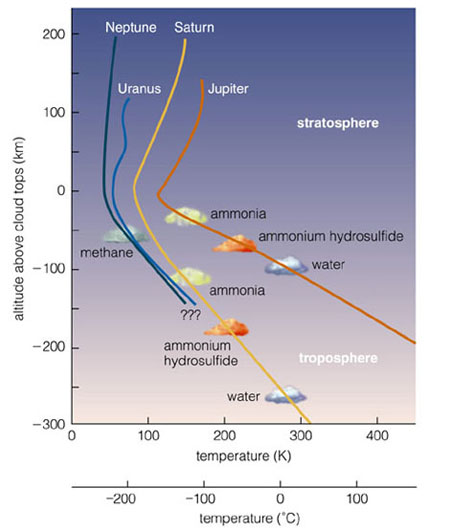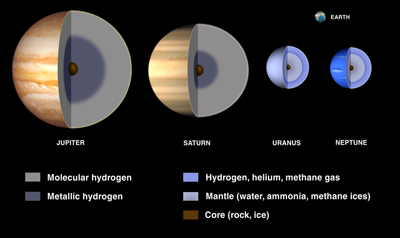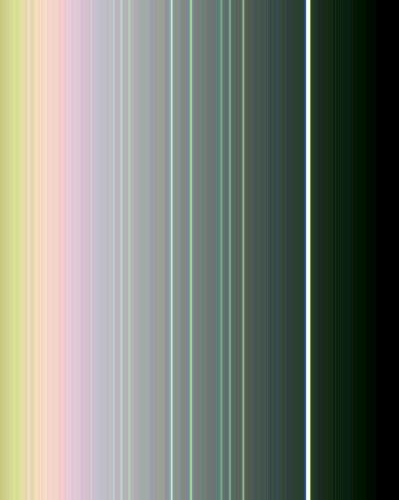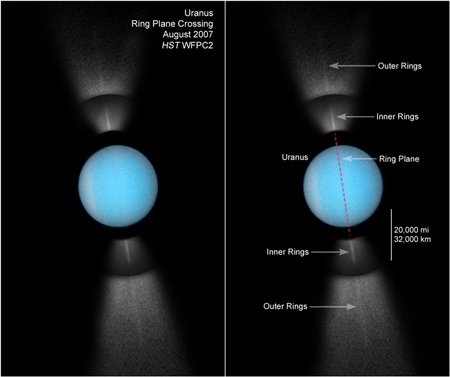Uranus was discovered by accident by Sir William
Herschel in 1781. While systematically surveying the
sky, he noticed a "star" that seemed to shift in one
direction in the sky. After plotting its course and
applying
Newtonian math, he was able to determine
this
star was in fact a planet, twice the distance
from the
Sun as
Saturn.We know very little about
Uranus and much of our knowledge comes from only one
probe and
Earth based observation. What we do know
is there are differences when compared to
Jupiter and
Saturn. In addition, the axis of rotation is
tilted by 98º so
that the north and south poles face the
Sun at
alternate times.
Uranus - A Quick Summary: (More information at Uranus Fact Sheet and Uranian Rings Fact Sheet)
 |
Average Distance from Sun: |
2.871 x 109 km |
| Eccentricity of Orbit: |
0.0429 |
| Average Orbital Speed: |
6.83 km/s |
| Orbital Period: |
84.099 years |
| Rotational Period: |
17.24 hours |
| Inclination of Equator to
Orbit |
97.86º |
| Diameter: |
51,118 km |
| Mass: |
8.682 x 1025 kg |
 |
Average Density: |
1318 kg/m3 |
| Escape Speed: |
21.3 km/s |
| Albedo: |
0.56 |
| Average Cloud-Top
Temperature: |
-218º
C |
 |
| Atmospheric
Composition |
82.5% hydrogen |
| 15.2% helium |
| 2.3% methane |
Back to Top The Atmosphere and
Interior:
The atmosphere of Uranus is gaseous
like
Jupiter and
Saturn, but contains a higher ratio
of heavier elements (to Astronomer's, a heavy
element is any element heavier than helium). There
is also a greater percentage of methane which
absorbs longer wavelengths resulting in the bluish
color. Like
Jupiter and
Saturn, Uranus rotates
differentially; however, there are no clearly
defined bands of clouds on Uranus. The wind speeds
on Uranus are at high speed - near 700 km/h - but
are in reverse at the equator (rotating to the west
instead of east). It is presumed this is the result
of the extreme tilt of Uranus resulting in more
sunlight at the poles verses the equator.The third
image above demonstrates the heating at the poles as
a result of the tilt. The diagram below demonstrates
the atmospheres of the Gas Giants, including Uranus:

The image above provides much information like gross
composition,
temperature and altitude. The image below demonstrates the interiors
of the Gas Giants:

Major differences between Uranus and both
Jupiter and
Saturn is the lack of liquid metallic hydrogen.
The differences between Uranus/Neptune and
Jupiter/Saturn is an area of active study. There are
two competing theories to explain the structural
differences and atmospheric differences:
-
Uranus and
Neptune formed closer
to the
Sun, at a distance between 4 and 10 A.U.
then moved outward
-
Uranus and
Neptune formed
independently from the rest of the Solar System,
but used material from the Solar Nebula
In other words, Uranus and
Neptune should have less heavier elements than
Jupiter and
Saturn, not more. To add to confusion, the magnetic
field of Uranus is tilted by 59º
versus the average tilt of about 12º.
Back
to Top The Rings: The rings of
Uranus are very thin and are possibly made of
methane-ice. The very narrow
orbits of these rings
are possibly the result of the numerous shepherd
moons surrounding the ring. Collectively, the rings
are called the U-Rings - U meaning Uranus.

The dark color of the rings may be the result of
converting methane-ice to carbon ice, a process
called radiation darkening. This is one
explanation for the low reflectivity of the rings.
The image below demonstrates a color enhancement of
a Voyager 2 image. This shows all 9 rings.

The beautiful colors are the result of the computer
enhancements and are not a natural feature of the
ring.
Hubble recently imaged the ring system whichs shows just how narrow they can be.


Back
to Top |

